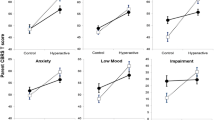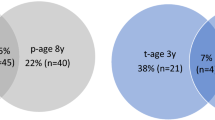Abstract
To examine the importance of symptom pervasiveness in ADHD, we conducted a prospective, 12-year follow-up study of boys (ages 6–12) considered hyperactive at school and home (Pervasive ADHD), boys considered hyperactive by teachers but not parents (School Only ADHD), boys considered hyperactive by parents but not teachers (Home Only ADHD), and nonhyperactive comparisons. Follow-up was completed on 82–94% participants. Clinicians interviewed participants and their parents, blind to childhood status. At follow-up, antisocial disorder was significantly more prevalent among Pervasive and School Only ADHD (29% for both) than Home Only ADHD (0%) and comparisons (8%). In a similar manner, severity of behavioral problems distinguished groups (Pervasive, School > Home, comparisons), as did educational attainment and academic performance (poorest for Pervasive and School). These findings stress the validity of teacher reports in the diagnosis of ADHD.
Similar content being viewed by others
REFERENCES
American Psychiatric Association. (1968). Diagnostic and statistical manual of mental disorders (2nd ed.). Washington, DC: American Psychiatric Association.
American Psychiatric Association. (1980). Diagnostic and statistical manual of mental disorders (3rd ed.). Washington, DC: American Psychiatric Association.
American Psychiatric Association. (1987). Diagnostic and statistical manual of mental disorders (Rev. 3rd ed.). Washington, DC: American Psychiatric Association.
American Psychiatric Association. (1994). Diagnostic and statistical manual of mental disorders (4th ed.). Washington, DC: American Psychiatric Association.
Anderson, J. C., Williams, S., McGee, R., & Silva, P. A. (1987). DSM-III disorders in preadolescent children: Prevalence in a large sample from the general-population. Archives of General Psychiatry, 44, 69–76.
August, G. J., & Garfinkel, B. D. (1998). Issues in the classification of disruptive behavior and attention deficit disorders. In T. A. Widiger, A. J. Frances, H. A. Pincus, R. Ross, M. B. First, W. Davis, & M. Kline (Eds.), DSM-IV sourcebook (Vol. 4, pp. 427–448). Washington, DC: American Psychiatric Association.
Barkley, R. A. (1998). Attention-deficit hyperactivity disorder (2nd ed.). New York: Guilford.
Beck, S. J., Young, G. H., & Tarnowski, K. J. (1990). Maternal characteristics and perceptions of pervasive and situational hyperactives and normal controls. Journal of the American Academy of Child and Adolescent Psychiatry, 29, 558–565.
Biederman, J., Faraone, S. V., Keenan, K., Steingard, R., & Tsuang, M. T. (1991). Familial association between attention deficit disorder and anxiety disorders. American Journal of Psychiatry, 148, 251–256.
Boudreault, M., Thivierge, J., Cote, R., Boutin, P., Julien, Y., & Bergeron, S. (1988). Cognitive development and reading achievement in pervasive-ADD, situational-ADD and control children. Journal of Child Psychology and Psychiatry, 29, 611–619.
Campbell, S. B., Endman, M. W., & Bernfeld, G. (1977a). A three-year follow-up of hyperactive preschoolers into elementary school. Journal of Child Psychology and Psychiatry, 18, 239–249.
Campbell, S. B., Schleifer, M., Weiss, G., & Perlman, T. (1977b). A two-year follow-up of hyperactive preschoolers. American Journal of Orthopsychiatry, 47, 149–162.
Cohen, N. J., & Minde, K. (1983). The “hyperactive syndrome” in kindergarten children: Comparison of children with pervasive and situational symptoms. Journal of Child Psychology and Psychiatry, 24, 443–455.
Conners, C. K. (1969). A teacher rating scale for use in drug studies with children. American Journal of Psychiatry, 126, 152–156.
Costello, E. J., Loeber, R., & Stouthamer-Loeber, M. (1991). Pervasive and situational hyperactivity — confounding effect of informant: A research note. Journal of Child Psychology and Psychiatry, 32, 367–376.
Daniel, W. W. (1999). Biostatistics (7th ed.). New York: Wiley.
Fleiss, J. L., Williams, J. B. W., & Dubro, A. F. (1986). The logistic regression analysis of psychiatric data. Journal of Psychiatric Research, 20, 195–209.
Gittelman, R., Abikoff, H., Pollack, E., Klein, D. F., Katz, S., & Mattes, J. (1980). A controlled trial of behavior modification and methylphenidate in hyperactive children. In C. Whalen & B. Henker (Eds.), Hyperactive children (pp. 221–243). Orlando: Academic Press.
Gittelman, R., & Mannuzza, S. (1985). Diagnosing ADD-H in adolescents. Psychopharmacology Bulletin, 21, 237–242.
Gittelman, R., Mannuzza, S., Shenker, R., & Bonagura, N. (1985). Hyperactive boys almost grown up: I. Psychiatric status. Archives of General Psychiatry, 42, 937–947.
Gittelman-Klein, R., Klein, D. F., Katz, S., Saraf, K., & Pollack, E. (1976). Comparative effects of methylphenidate and thioridazine in hyperkinetic children. Archives of General Psychiatry, 33, 1217–1231.
Hollingshead, A. B., & Redlich, F. C. (1958). Social class and mental illness. New York: Wiley.
Klein, D. F., & Gittelman-Klein, R. (1975). Problems in the diagnosis of minimal brain dysfunction and the hyperkinetic syndrome. International Journal of Mental Health, 4, 45–60.
Mannuzza, S., & Klein, R. G. (1988, September). Modifying the diagnostic interview schedule to study adolescents and young adults. DIS Newsletter, 5, 10–12.
Mannuzza, S., Klein, R. G., Bessler, A., Malloy, P., & Hynes, M. E. (1997). Educational and occupational outcome of hyperactive boys grown up. Journal of the American Academy of Child and Adolescent Psychiatry, 36, 1222–1227.
Mannuzza, S., Klein, R. G., Bessler, A., Malloy, P., & LaPadula, M. (1993). Adult outcome of hyperactive boys: Educational achievement, occupational rank, and psychiatric status. Archives of General Psychiatry, 50, 565–576.
Mannuzza, S., Klein, R. G., Bonagura, N., Konig, P. H., & Shenker, R. (1988). Hyperactive boys almost grown up: II. Status of subjects without a mental disorder. Archives of General Psychiatry, 45, 13–18.
Mannuzza, S., Klein, R. G., Bonagura, N., Malloy, P., Giampino, T. L., & Addalli, K. A. (1991). Hyperactive boys almost grown up: V. Replication of psychiatric status. Archives of General Psychiatry, 48, 77–83.
McBurnett, K. (1997). Attention-deficit/hyperactivity disorder: A review of diagnostic issues. In T. A. Widiger, A. J. Frances, H. A. Pincus, R. Ross, M. B. First, & W. Davis (Eds.), DSM-IV sourcebook (Vol. 3, pp. 111–143). Washington, DC: American Psychiatric Association.
MTA Cooperative Group. (1999). A 14–month randomized clinical trial of treatment strategies for attention-deficit/hyperactivity disorder. Archives of General Psychiatry, 56, 1073–1086.
Rapoport, J. L., Donnelly, M., Zametkin, A., & Carrougher, J. (1986). Situational hyperactivity in a U.S. clinical setting. Journal of Child Psychology and Psychiatry, 27, 639–646.
Robins, L. N., Helzer, J. E., Croughan, J., & Ratcliff, K. S. (1981). The NIMH Diagnostic Interview Schedule: Its history, characteristics, and validity. Archives of General Psychiatry, 38, 381–389.
Sandberg, S. T., Rutter, M., & Taylor, E. (1978). Hyperkinetic disorder in psychiatric clinic attenders. Developmental Medicine and Child Neurology, 20, 279–299.
Schachar, R., Rutter, M., & Smith, A. (1981). The characteristics of situationally and pervasively hyperactive children: Implications for syndrome definition. Journal of Child Psychology and Psychiatry, 22, 375–392.
Schleifer, M., Weiss, G., Cohen, N., Elman, M., Cvejic, H., & Kruger, E. (1975). Hyperactivity in preschoolers and the effect of methylphenidate. American Journal of Orthopsychiatry, 45, 38–50.
Szatmari, P., Offord, D. R., & Boyle, M. H. (1989). Ontario child health study: Prevalence of attention deficit disorder with hyperactivity. Journal of Child Psychology and Psychiatry, 30, 219–230.
Tripp, G., & Luk, S. L. (1997). The identification of pervasive hyperactivity: Is clinic observation necessary? Journal of Child Psychology and Psychiatry, 38, 219–234.
Wechsler, D. (1949). Wechsler intelligence scale for children. New York: Psychological Corporation.
Wechsler, D. (1974). Wechsler intelligence scale for children — revised. New York: Psychological Corporation.
Werry, J. S., & Sprague, R. L. (1970). Hyperactivity. In C. G. Costello (Ed.), Symptoms of psychopathology (pp. 397–417). New York: Wiley.
World Health Organization. (1978). The international classification of disease (9th ed.). Geneva: World Health Organization.
World Health Organization. (1992). The international classification of disease (10th ed.). Geneva: World Health Organization.
Author information
Authors and Affiliations
Rights and permissions
About this article
Cite this article
Mannuzza, S., Klein, R.G. & Moulton, J.L. Young Adult Outcome of Children with “Situational” Hyperactivity: A Prospective, Controlled Follow-Up Study. J Abnorm Child Psychol 30, 191–198 (2002). https://doi.org/10.1023/A:1014761401202
Issue Date:
DOI: https://doi.org/10.1023/A:1014761401202




